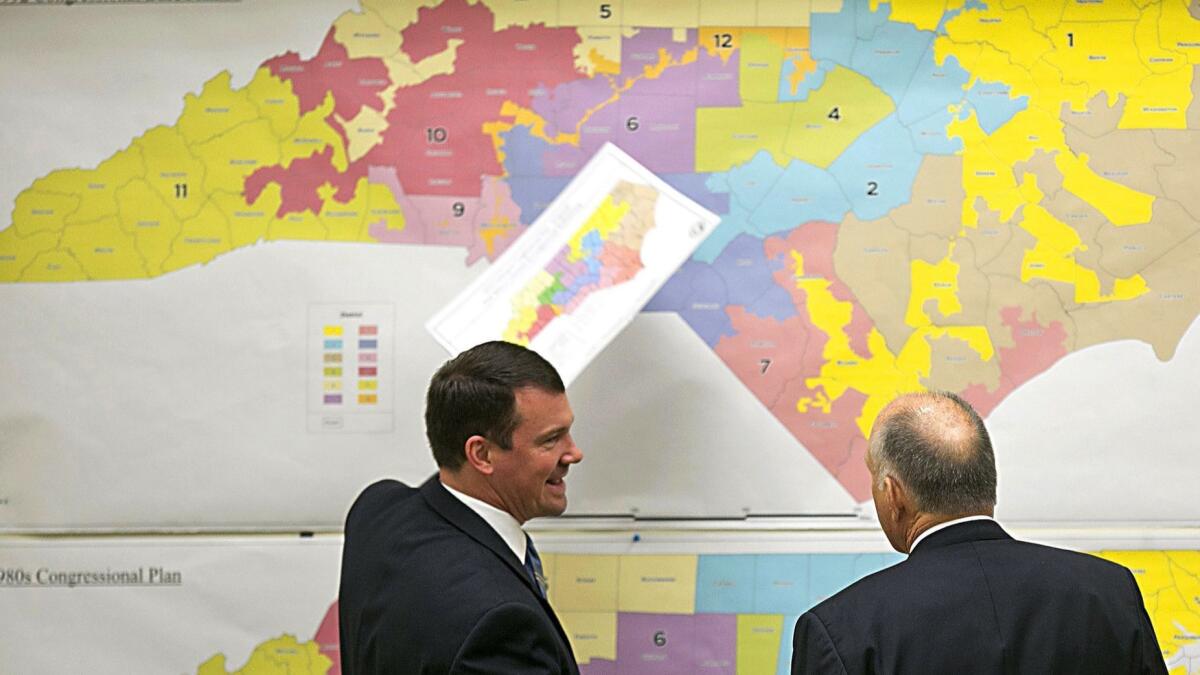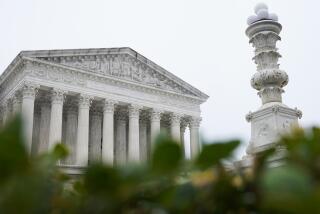Supreme Court to decide on partisan gerrymandering in North Carolina and Maryland

- Share via
Reporting from Washington — The Supreme Court will review highly partisan election maps drawn by Republicans in North Carolina and Democrats in Maryland, and decide whether such political gerrymandering violates voters’ rights to a fair election.
In North Carolina, the state’s Republican leaders drew the congressional districts to lock in a 10-3 advantage for their candidates, even when the state’s votes were evenly split.
In Maryland, Democratic leaders shifted more than 100,000 voters to transform a safe Republican district into a reliably Democratic one. As a result, seven of its eight seats are held by Democrats.
The high court agreed Friday to review the cases. Rulings, due by June, will probably determine whether there will be legal checks on the state politicians who will redraw election districts following the 2020 census. The court said it would hear arguments in March in two cases: Rucho vs. Common Cause and Benisek vs. Lamone.
Partisan gerrymandering is not a new problem, and the challengers face an uphill fight because of the retirement of Justice Anthony M. Kennedy. The high court has never struck down an election map as unfairly political, but Kennedy — a conservative who sometimes sided with the court’s liberals — had left the door open to ruling that an extremely skewed map might violate the 1st Amendment.
Last year, the court considered two partisan gerrymander cases — from Wisconsin and Maryland — but cited procedural grounds for not issuing definitive rulings.
In the past, Chief Justice John G. Roberts Jr. has suggested judges have no role to play in policing the drawing of election districts. And now that Kennedy has been replaced by the more conservative Justice Brett M. Kavanaugh, the chief justice may well have a majority to rule that drawing voting districts is an inherently political task to be decided solely by state lawmakers, not judges.
Such a ruling could backfire on Republicans, however. The GOP won big victories in a 2010 midterm wave election and took full control of state governments including those in Pennsylvania, Ohio, Wisconsin, Michigan and North Carolina. Republicans used their power to draw election maps that virtually guaranteed their party would win about three-fourths of the seats throughout the decade.
In 2016, for example, Pennsylvania, Ohio and Michigan had 48 seats in the U.S. House, and they sent 34 Republicans and 14 Democrats to Washington.
But 2020 is a presidential election year, and Democrats are likely to fare much better then, building on the state victories they racked up in November. If so, Democrats are likely to take as much advantage as possible when the election districts are redrawn with new census data, especially if the high court gives its approval to partisan line-drawing.
Critics of partisan gerrymandering say they hope the high court will end the practice.
“Voters nationwide are ready for a ruling from the Supreme Court that finally declares that they come first, not self-interested politicians,” said Paul Smith, a lawyer for the Campaign Legal Center. “If the Supreme Court fails to set limits on this undemocratic practice, we will see a festival of copycat gerrymandering in 2020 the likes of which the country has never seen before.”
Opponents of partisan gerrymandering in North Carolina and Maryland have unusually strong cases because the political leaders in those states candidly admitted they were drawing the maps for political advantage. But they emphasized that they were not gerrymandering by race, which the high court had ruled is unconstitutional.
“I’m making clear that our intent is to use the political data we have for partisan advantage,” said North Carolina state Rep. David Lewis, a Republican, when lawmakers there met in a special session in Raleigh two years ago to revise the congressional districts.
Lewis announced he would go as far as possible to benefit Republicans. “I propose that we draw the maps to give a partisan advantage of 10 Republicans and three Democrats because I do not believe it’s possible to draw a map with 11 Republicans and two Democrats,” he said.
Voters who leaned in favor of Democrats were concentrated in three districts, while 10 districts were drawn to give Republicans safe but not overwhelming margins.
In November, the plan worked as intended. North Carolina’s voters were closely split in statewide tallies, with Republicans holding a 51%-49% edge. But the GOP again won 10 of the 13 House seats — although one race remains in doubt because of allegations of fraud in the handling of absentee ballots.
Lawyers for Common Cause and the League of Women Voters had sued, alleging this partisan manipulation of the districts violates the voters’ rights to a fair election and an equal vote.
Twice they won before a three-judge federal district court, which called the election map discriminatory in its intent and its effect. The judges said the politically tilted map violated the 1st Amendment because it diluted the votes of some voters based on their political views, and it denied them equal protection of the laws.
But the Supreme Court set aside the first ruling in June, so this election could proceed with the GOP-drawn map.
In their appeal, lawyers for the North Carolina Republicans said there was no “manageable standard” for a court to decide when politics play too large a role in drawing district lines. They also said voters do not have a right to “proportional representation” in the number of seats won based on statewide results.
In past cases, Roberts has said the Constitution leaves the redistricting power to state legislatures. He has pointed to a provision that says: “The times, places and manner of holding elections for senators and representatives shall be prescribed in each state by the Legislature.”
Four years ago, he would have struck down the voter-approved independent commissions in California, Arizona and several other states on the grounds that this map-drawing power resided with the state legislatures. But he lost in a 5-4 decision when the now-retired Kennedy joined the four liberals in a case from Arizona.
The chief justice recently spoke for the court in overturning an anti-gerrymandering ruling from a three-judge federal court in Wisconsin, but he did so based on procedural grounds. The district judges said the state map was drawn to “entrench” one party in power for at least a decade. However, Roberts said the plaintiffs who voted in local elections did not have standing to challenge the statewide election map.
Last month, the politically drawn map allowed Wisconsin’s Republicans to retain a supermajority of 63 of the 99 seats in the state Assembly, despite winning only 46% of the statewide vote. Democrats won the statewide races in Wisconsin, including for governor and attorney general, but the voters’ shift toward the Democrats had no impact on political makeup of the state Legislature.
More stories from David G. Savage »
Twitter: DavidGSavage
More to Read
Get the L.A. Times Politics newsletter
Deeply reported insights into legislation, politics and policy from Sacramento, Washington and beyond. In your inbox three times per week.
You may occasionally receive promotional content from the Los Angeles Times.











